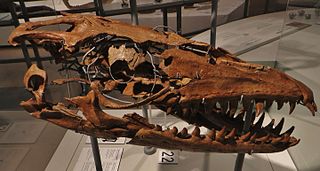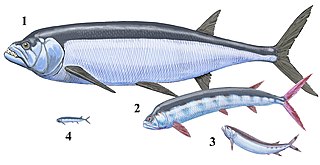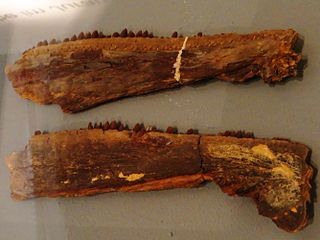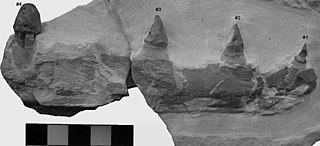
The Mosasaurinae are a subfamily of mosasaurs, a diverse group of Late Cretaceous marine squamates. Members of the subfamily are informally and collectively known as "mosasaurines" and their fossils have been recovered from every continent except for South America.

Globidens is an extinct genus of mosasaurid oceanic lizard classified as part of the Globidensini tribe in the Mosasaurinae subfamily. Globidens belongs to the family Mosasauridae, which consists of several genera of predatory marine lizards of various sizes that were prevalent during the Late Cretaceous. Specimens of Globidens have been discovered in Angola, Brazil, Morocco, Syria and the United States. Among mosasaurs, Globidens is probably most well known for the highly rounded, globe-like teeth that give it its name.

Protostega is an extinct genus of sea turtle containing a single species, Protostega gigas. Its fossil remains have been found in the Smoky Hill Chalk formation of western Kansas, time-equivalent beds of the Mooreville Chalk Formation of Alabama and Campanian beds of the Rybushka Formation. Fossil specimens of this species were first collected in 1871, and named by Edward Drinker Cope in 1872. With a total length of 3.9 metres (13 ft), it is the second-largest sea turtle that ever lived, second only to the giant Archelon, and one of the three largest turtle of all time along Archelon and Gigantatypus.

Prognathodon is an extinct genus of marine lizard belonging to the mosasaur family. It is classified as part of the Mosasaurinae subfamily, alongside genera like Mosasaurus and Clidastes. Prognathodon has been recovered from deposits ranging in age from the Campanian to the Maastrichtian in the Middle East, Europe, New Zealand, and North America.
Carinodens is an extinct genus of Cretaceous marine lizard belonging to the mosasaur family. "Carinodens" means "keel teeth" and was named in 1969 as a replacement name for Compressidens, "compressed teeth", which was already in use for a gadilidan scaphopod mollusk.

Schizorhiza is an extinct genus of schizorhizid sclerorhynchoid that lived during the Late Cretaceous. It contains one valid species, Schizorhiza stromeri. It lived from the Campanian to Maastrichtian, and its fossils have been found in Africa, the Middle East, North America, and South America.

Ichthyodectiformes is an extinct order of marine stem-teleost ray-finned fish. The order is named after the genus Ichthyodectes, established by Edward Drinker Cope in 1870. Ichthyodectiforms are usually considered to be some of the closest relatives of the teleost crown group.

The Maastricht Formation, named after the city of Maastricht in the Netherlands, is a geological formation in the Netherlands and Belgium whose strata date back to the Late Cretaceous, within 500,000 years of the Cretaceous–Paleogene boundary, now dated at 66 million years ago. The formation is part of the Chalk Group and is between 30 and 90 metres thick. It crops out in southern parts of Dutch and Belgian Limburg and adjacent areas in Germany. It can be found in the subsurface of northern Belgium and southeastern Netherlands, especially in the Campine Basin and Roer Valley Graben. Dinosaur remains are among the fossils that have been recovered from the formation.

Saurocephalus is an extinct genus of ray-finned fishes within the family Saurodontidae. The genus was first described in 1824 and contains six or seven species, including the type species S. lanciformis. Saurocephalus first appeared during the early Valanginian and continued on to the Maastrichtian, where it nearly went extinct. However, the recent discovery of S. lanciformis remains from the earliest Paleocene indicates that it just barely survived into the Cenozoic. This would make it the last surviving ichthyodectiform.

Wadi Harrana is a seasonal stream (wadi) in the eastern Jordanian Badia, about sixty kilometers southeast of the city of Amman. It runs eastwards from the edge of the Jordanian Highlands to the Azraq oasis.

Gigantatypus is an extinct late Maastrichtian sea turtle that lived in the southern regions of the Tethys Ocean about 100–120 kilometres (62–75 mi) off the north eastern margins of Cretaceous Africa immediately before the Cretaceous–Paleogene extinction events . Fossil remains of Gigantatypus are so far only represented in sediments from the Muwaqqar Chalk-Marl Formation of Jordan. Estimated at over 3.5 metres (11 ft) in length, members of this genus reached remarkably large proportions equivalent to that of or possibly even exceeding Archelon Wieland, 1896, considered as the largest marine turtles to ever roam the oceans of the world. Although Gigantatypus apparently did not survive the K/T boundary, which also was the fate of other gigantic marine turtles such as protostegids, other genera of Cheloniidae, though significantly smaller, survived the mass extinction and continued on until the present day.

Nyctosauridae is a family of specialized soaring pterosaurs of the late Cretaceous Period of North America, Africa, and possibly other continents including South America. It was named in 1889 by Henry Alleyne Nicholson and Richard Lydekker.

Argentina is a genus of fishes in the family Argentinidae.

Harranasaurus is an extinct genus of globidensin mosasaur from Jordan. The genus contains one known species, H. khuludae from the Muwaqqar Chalk Marl Formation of Jordan.
Schizorhizidae is an extinct family of cartilaginous fish from the Late Cretaceous belonging to the suborder Sclerorhynchoidei. This family contains the genera Harranahynchus and Schizorhiza. It was originally named as a subfamily of Sclerorhynchidae, but was later raised to the rank of family.
Rarosaurus is an extinct genus of marine reptile that lived during the Late Cretaceous. It contains one valid species, R. singularis, and it was found in the Muwaqqar Chalk Marl Formation of Jordan.

Inabtanin is an extinct genus of azhdarchoid pterosaurs from the Late Cretaceous Muwaqqar Formation of Jordan. The genus contains a single species, I. alarabia, known from a partial skeleton. Inabtanin represents one of the most complete pterosaur taxa known from the Afro-Arabia region.
The Muwaqqar Chalk-Marl Formation or Muwaqqar Formation is a Late Cretaceous (Maastrichtian) and early Paleogene-aged geological formation in Jordan, cropping out across the Jordanian Highlands from north to south. It is the geological formation containing Jordan's famous oil shales, which are among the largest in the world. Some outcrops of the formation contain extremely well-preserved fossils, making it a lagerstätte.













